
Bastar is a district in the state of Chhattisgarh in Central India. Jagdalpur is the district headquarters. Bastar is bounded on the northwest by Narayanpur District, on the north by Kondagaon district, on the east by Nabarangpur and Koraput Districts of Odisha State, on the south and southwest by Dantewada and Sukma. The district possesses a unique blend of tribal and Odia culture.

Uttar Bastar Kanker District is located in the southern region of the state of Chhattisgarh, India within the latitudes 20.6-20.24 and longitudes 80.48-81.48. The total area of the district is 6432 square kilometers. The population is 748,941.
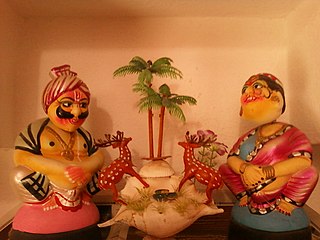
Kondapalli Toys are toys made of wood in Kondapalli of Krishna district, a nearby Vijayawada in the Indian state of Andhra Pradesh. Bommala Colony translates to Toys Colony in Kondapalli is the place where the art of crafting takes place. It was registered as one of the geographical indication handicraft from Andhra Pradesh as per Geographical Indications of Goods Act, 1999. This GI application was filed by LIGHT and Kondapalli Wooden Toys Manufacturers.These toys were one of the varieties of toys assembled in the houses during the festivals of Sankranti and Navratri and is referred as Bommala Koluvu.

Bagh print is a traditional Indian handicraft originating in Bagh, Dhar district of Madhya Pradesh, India. The process is characterised by hand printed wood block relief prints with naturally sourced pigments and dyes. Bagh print motifs are typically geometric, paisley, or floral compositions design, dyed with vegetable colours of red and black over a white background, and is a popular textile printing product. Its name is derived from the village Bagh located on the banks of the Bagh River.

Kashmiri papier-mâché is a handicraft of Kashmir that was brought by Muslim saint Mir Sayyid Ali Hamadani from Persia in the 14th century to medieval India. It is based primarily on paper pulp, and is a richly decorated, colourful artifact; generally in the form of vases, bowls, or cups, boxes, trays, bases of lamps, and many other small objects. These are made in homes, and workshops, in Srinagar, and other parts of the Kashmir Valley, and are marketed primarily within India, although there is a significant international market. The product is protected under the Geographic Indication Act 1999 of Government of India, and was registered by the Controller General of Patents Designs and Trademarks during the period from April 2011 to March 2012 under the title "Kashmir Paper Machie".

The Thanjavur Art Plate is an artifact which is exclusively made in Thanjavur, Tamil Nadu, India. It is a circular plate made as a gift item. It is a handicraft consisting of metals such as silver, bronze, and copper embossed with figures of gods and goddesses at its center. The artwork has been registered for protection under the Geographical indication of the Trade Related Intellectual Property Rights (TRIPS) agreement. It is listed at item 63 as "Thanjavur Art Plate" of the GI Act 1999 of the Government of India, with registration confirmed by the Controller General of Patents Designs and Trademarks. Only the size of the article is permitted to be different while other metal compositions and particularization have to remain the same as per GI approval.
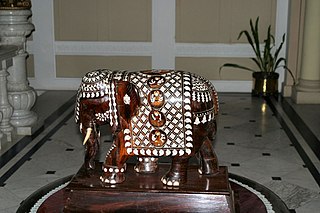
Mysore Rosewood Inlay covers a range of techniques used by artisans in around the area of Mysore in sculpture and the decorative for inserting pieces of contrasting, often coloured materials like ivory shells, mother-of-pearl, horn and sandalwood into depressions in a rosewood object to form ornament or pictures that normally are flush with the matrix. These artifacts are manufactured in around the region of Mysore, these artifacts have been awarded Geographical Indication tag from the Government of India in 2005 due to its historic representation as an artifact depicting the region and the design and style used by the local artisans

Sankheda furniture is colourful teak wood furniture of Gujarat, India, treated with lacquer and painted in traditional bright shades of maroon and gold. It is made in Sankheda village and hence its name. The village is located about 45 kilometres (28 mi) from Vadodara.

Odisha Ikat, is a kind of ikat known as Bandhakala and Bandha, a resist dyeing technique, originating from Indian state of Odisha. Traditionally known as "Bandhakala"', "Bandha", '"Bandha of Odisha", it is a geographically tagged product of Odisha since 2007. It is made through a process of tie-dyeing the warp and weft threads to create the design on the loom prior to weaving. It is unlike any other ikat woven in the rest of the country because of its design process, which has been called "poetry on the loom". This design is in vogue only at the western and eastern regions of Odisha; similar designs are produced by community groups called the Bhulia, Kostha Asani, and Patara. The fabric gives a striking curvilinear appearance. Saris made out of this fabric feature bands of brocade in the borders and also at the ends, called anchal or pallu. Its forms are purposefully feathered, giving the edges a "hazy and fragile" appearance. There are different kinds of bandha saris made in Odisha, notably Khandua, Sambalpuri, Pasapali, Kataki and Manibandhi.
Navalgund durries, geographically tagged in India, are woven durries or a type of Indian rug with geometric designs, birds, and animal designs from Navalgund in Dharwad district of Karnataka, India
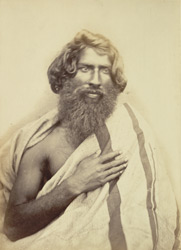
The Toda Embroidery, also locally known as "pukhoor", is an art work among the Toda pastoral people of Nilgiris, in Tamil Nadu, made exclusively by their women. The embroidery, which has a fine finish, appears like a woven cloth but is made with use of red and black threads with a white cotton cloth background. Both sides of the embroidered fabric are usable and the Toda people are proud of this heritage. Both men and women adorn themselves with the embroidered cloaks and shawls.

Khurja pottery is traditional Indian pottery work manufactured in Khurja of the Bulandshahr district in Uttar Pradesh state, India. Khurja pottery has been protected under the Geographical indication (GI) of the Agreement on Trade-Related Aspects of Intellectual Property Rights (TRIPS) agreement. It is listed at item 178 as "Khurja Pottery" of the GI Act 1999 of the Government of India with registration confirmed by the Controller General of Patents Designs and Trademarks.
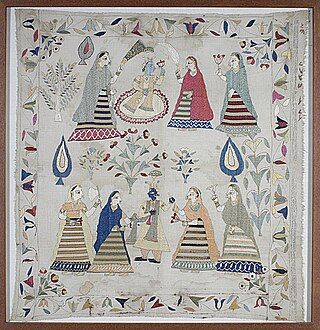
The Chamba Rumal or Chamba handkerchief is an embroidered handicraft that was once promoted under the patronage of the former rulers of Chamba kingdom. It is a common item of gift during marriages with detailed patterns in bright and pleasing colour schemes.

The Kutch Embroidery is a handicraft and textile signature art tradition of the tribal community of Kutch District in Gujarat, India. This embroidery with its rich designs has made a notable contribution to the Indian embroidery traditions. The embroidery, practiced normally by women is generally done on fabrics of cotton, in the form of a net using cotton or silk threads. In certain patterns, it is also crafted over silk and satin. The types of stitches adopted are “square chain, double buttonhole, pattern darning, running stitch, satin and straight stitches”. The signature effect of the colorful embroidery sparkles when small mirrors called abhla are sewn over the geometrically shaped designs. Depending on the tribal sub groups of Rabari, Garasia Jat, and Mutava involved with this craft work many hand embroidered ethnic styles have evolved. These six styles: Suf, khaarek, paako, Rabari, Garasia Jat, and Mutava.

Santiniketan Leather Goods are leather products made in Santiniketan and surrounding villages near Kolkata, West Bengal, India. The material used is vegetable tanned leather with art work done by touch dyeing. Its artistic leather bags are popular in foreign markets and are exported to many countries including Japan and the U.S. They are generally made of E. I. Leather from sheepskin and goatskin.
The Surat Zari / Jari Craft is a textile product of Surat district in Gujarat, India, which is made from yarns of silk and cotton mixed with gold, silver or copper. The zari threads are used to make intricate designs by weaving into generally silk fabrics. Its use is extensive in textile industries and handicrafts. The Surat Zari is either woven on cloth or hand embroidered to form fabric borders or used as part on the body of the cloth. The zaris are used in fabrics made in Varanasi and a few other places in Uttar Pradesh, Tamil Nadu, Karnataka and Andhra Pradesh. Banarasi saris made in Varanasi and Kanjivaram Saris of South India use Surat Zari extensively.

The Villianur Terracotta Works are handicrafts made from fine green clay, fine sand and thennal which are hand made by villagers of Villianur, in the union territory Pondicherry also spelled Pudhucherry, India. It has a history of more than 20 generations.

Solapur Terry Towel is terry towel weaving or knitting work that are manufactured in the Solapur district of Maharashtra state, India. The terry towel work has been protected under the Geographical indication (GI) of the Agreement on Trade-Related Aspects of Intellectual Property Rights (TRIPS) agreement. It is listed at item 9 as "Solapur Terry Towel" of the GI Act 1999 of the Government of India with registration confirmed by the Controller General of Patents Designs and Trademarks.
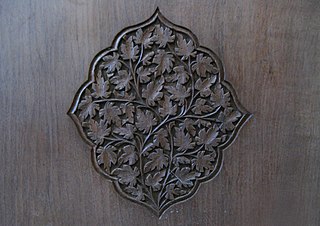
Kashmir walnut wood carving is wood carving work that is manufactured in Jammu and Kashmir, India. Walnut carving is protected under the geographical indication (GI) of the Agreement on Trade-Related Aspects of Intellectual Property Rights (TRIPS) agreement. It is listed at item 182 as "Kashmir Walnut Wood Carving" of the GI Act 1999 of the Government of India with registration confirmed by the Controller General of Patents Designs and Trademarks.
Bastar Iron Craft is a traditional Indian iron crafts that are manufactured in the Bastar district of Chhattisgarh state, India. The iron-crafting work has been protected under the geographical indication (GI) of the Agreement on Trade-Related Aspects of Intellectual Property Rights (TRIPS) agreement. It is listed at item 82 as "Bastar Iron Craft" of the GI Act 1999 of the Government of India with registration confirmed by the Controller General of Patents Designs and Trademarks.

















